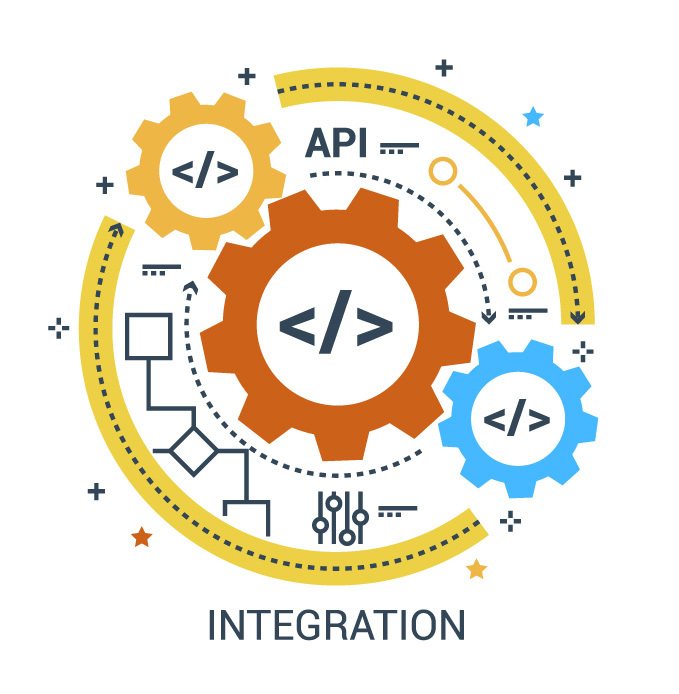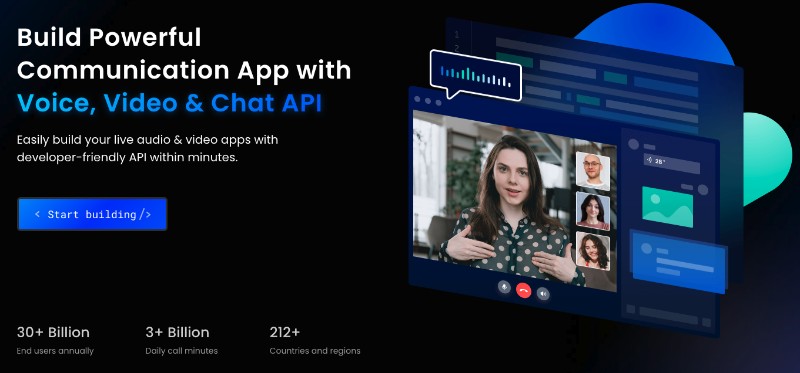API Integration is an essential mechanism in today’s technological landscape, seamlessly linking disparate software systems to enhance overall functionality. It plays a pivotal role in streamlining operations, improving user experiences, and driving innovation, making it a cornerstone of modern digital ecosystems. Today, we will guide you through what API integration is and why it is important.
What Are Rest APIs and How do Rest APIs Work?
REST API is a type of web service that enables communication between software applications over the internet. It follows the REST architectural style, providing principles for building scalable and flexible distributed systems. At its core, REST APIs use HTTP methods (such as GET, POST, PUT, and DELETE) to allow clients to perform operations on server-hosted resources. These resources are exposed through unique Uniform Resource Identifiers (URIs) that act as addresses for accessing and manipulating them.
When a client wants to interact with a REST API, it sends an HTTP request to the server, specifying the desired method and resource URI. The server processes the request, which may involve retrieving data, updating records, or executing business logic. Once the server completes processing, it returns an HTTP response with a status code indicating the success or failure of the request, along with any data or error messages. REST APIs commonly use JSON or XML as data formats for request and response bodies.
An important characteristic of REST APIs is their stateless nature, where each request is independent and doesn’t rely on previous requests or server-stored information. This allows for easier scalability and distribution of the system. By adhering to REST principles, APIs provide a standardized and uniform way for different applications to communicate and exchange data. They have become widely adopted for building web services used by various clients, including web browsers and mobile apps.
What is API Integration Meaning?
API integration allows different software systems to collaborate and share information effortlessly. It connects various applications using a set of rules and protocols called an Application Programming Interface (API).
An e-commerce website can use API integration to connect to a payment gateway and allow customers to make payments directly. In healthcare, it can connect electronic health record systems and share patient information. It is vital for businesses because it can make processes more efficient and save time.
For developers, API integration makes building and maintaining applications easier. They can use pre-built APIs to add functionality to their applications without starting from scratch. This saves time and resources and allows developers to focus on creating unique features for their applications.
Overall, API integration is a crucial part of modern software development. As more devices connect to the internet and the need to share information grows, it will continue to play an important role in how software systems work together.
Why Do You Need API Integration?
API integration has become an essential tool for software development in recent years. It allows different systems to communicate with each other, share data and functionality, and ultimately create more advanced applications. Here are 7 reasons why you should consider it for your next project.
- Increased functionality: By integrating APIs from different platforms, you can add new features and functionality to your application without building everything from scratch. This can save you a significant amount of time and resources.
- Improved user experience: We can create a seamless user experience by allowing your application to communicate with other systems and platforms. For example, by integrating an API from a social media platform, you can allow users to log in to your application using their existing social media accounts.
- Better data management: API integration can help you manage data more effectively by allowing you to access and share information between different systems and platforms. You can make better decisions and improve the overall efficiency of your business.
- Cost-effective: By leveraging the existing functionality of other systems and platforms, API integration can save you a significant amount of money on development costs.
- Increased scalability: API integration allows you to easily expand and scale your application as your business grows.
- Better security: By integrating APIs from trusted platforms and systems, you can improve the security of your application.
- Better collaboration: API integration can help you collaborate more effectively with other businesses and organizations by allowing you to share data and functionality.
Must-have API Integration Features
We have different types of APIs available today. With so many options available, what are the must-have features that you should look for when integrating APIs? Here are 7 must-have features to consider when integrating APIs:
- Authentication: Authentication is the process of verifying the identity of a user or system. A secure and robust authentication system is essential for protecting sensitive data and ensuring that only authorized users have access to it.
- Authorization: Authorization is the process of determining whether a user or system is authorized to access specific resources or perform specific actions. This feature should be closely tied to the authentication feature to ensure that only authorized users can access the resources they need.
- Error handling: APIs are complex systems, and it’s essential to have a robust error-handling system in place to ensure that any issues are quickly identified and resolved. This feature should include detailed error messages and clear instructions for troubleshooting.
- Scalability: As your business grows, your API integration needs will change. Choosing an API that can scale with your business is essential so that you don’t have to replace it as your needs evolve.
- Performance: Performance is critical when it comes to API integration. A slow API can lead to poor user experience and even lost business. Choosing an API that offers high performance and low latency is essential.
- Support: API integration can be complex, and it’s essential to have access to support when you need it. Comprehensive documentation and a dedicated support team is also essential features, as they help you troubleshoot any issues.
- Security: Security should be a top priority regarding API integration. Look for an API that offers robust security features such as encryption, access control, and penetration testing to protect your data and your business.
Where to Use API Integration
API integration is a game-changer in the world of software development. It allows different systems to share data and functionality, making it possible to create more advanced applications. Imagine adding new features to your app without starting from scratch – that’s the power of API integrations. For example, Uber uses APIs to integrate Google Maps, allowing the app to provide accurate pick-up and drop-off locations.
Video conferencing is one of the most innovative use cases for API integration. Developers can craft custom solutions perfect for their business or organization by connecting different video conferencing platforms. Imagine being able to schedule, record, and share screens in a video conference with just a few lines of code.
Moreover, In logistics, API integration helps to track shipments and inventory in real-time by connecting different transport management systems. According to a report by Forrester, the global API market size is expected to reach $9.5 billion by 2024, growing at a CAGR of 18.9% during the forecast period.
In addition, API integration is not a one-size-fits-all solution. It’s a versatile tool that can solve a wide range of problems. It’s the key to unlocking the potential of your software and taking your business to the next level. Companies like Amazon, Netflix, and Spotify have leveraged the power of API integration to create seamless user experiences and drive their business growth.

What is the Cost of API Integration?
Understanding the cost of API Integration is crucial for businesses looking to enhance their digital infrastructure. API Integration, a process that connects different software systems to work as a unified solution, can vary significantly in cost based on several factors.
- Development Costs: The primary expenditure is hiring skilled developers for designing and constructing the integration. Additionally, investing in software development tools and frameworks is often required.
- Testing Costs: Comprehensive testing is crucial to validate the integration’s functionality and stakeholder alignment. This includes setting up testing environments and conducting both automated and manual tests.
- Integration Platform Costs: For complex integrations, utilizing an integration platform or middleware is essential. These vary from basic cloud-based solutions to advanced on-premise systems.
- Maintenance and Support Costs: Post-deployment, the integration requires ongoing maintenance and support. This is vital to ensure continued functionality and adaptability to business evolution.
The cost of API Integration depends on the complexity, number, customization, maintenance needs, and development approach. Each project is unique, and a thorough analysis is essential to estimate the accurate cost of integration for specific business requirements.
API Integration Best Practices
API integration is a crucial aspect of modern software development, enabling systems to communicate, exchange data, and leverage various functionalities. To ensure successful API integration, consider the following best practices:
1. Thoroughly Understand API Documentation: Take the time to thoroughly read and understand the API documentation provided by the API provider. This will ensure that you have a clear understanding of the API’s capabilities, endpoints, request/response formats, authentication methods, and any specific guidelines or restrictions.
2. Use Secure Authentication: Implement secure authentication methods, such as API keys, OAuth, or JWT, to ensure that only authorized users or applications can access the API. Implement encryption and hashing techniques to protect sensitive data during transmission.
3. Handle Errors Gracefully: Expect and handle errors that may occur during API integration. APIs may return errors due to invalid requests, rate limits, or server issues. Implement proper error handling mechanisms to gracefully handle these scenarios and provide meaningful error messages to users.
4. Implement Rate Limiting and Caching: Respect the rate limits defined by the API provider to avoid overloading their servers. Consider implementing caching mechanisms to reduce unnecessary API calls and improve performance, especially for frequently accessed or static data.
5. Validate and Sanitize User Input: Validate and sanitize all user input to prevent security vulnerabilities, such as SQL injection or cross-site scripting (XSS) attacks. Use input validation techniques like input whitelisting, parameterized queries, and output encoding to ensure the integrity of data passed to and received from the API.
6. Implement Robust Error Logging and Monitoring: Set up comprehensive error logging and monitoring systems to capture and track errors and exceptions that occur during API integration. This will help you proactively identify and resolve issues, ensuring the reliability and stability of your application.
How ZEGOCLOUD Accelerates API-based Integrations
ZEGOCLOUD is the leading API integration platform for developers aiming to incorporate real-time communication, live streaming, and video call features into their applications. With its powerful API and comprehensive UIKits, ZEGOCLOUD simplifies and accelerates the app development process. Developers can effortlessly integrate a range of communication and video capabilities, including live streaming, video conferencing, and real-time messaging, enabling them to build robust and feature-rich apps more efficiently.

This powerful integration API platform offers a wide range of features, making it the best choice for developers of all skill levels.
- ZEGOCLOUD API’s versatility shines, supporting iOS, Android, Flutter, and React Native, eliminating compatibility concerns.
- Offering 10,000 free minutes, it enables risk-free mobile and web app development and platform testing for developers.
- Furthermore, its user-friendly design and abundant resources, like documentation and tutorials, cater to developers at all skill levels.
- Besides its top-notch features and ease of use, ZEGOCLOUD API offers reliability and scalability, ideal for enterprise-level apps, with robust security ensuring data protection.
Conclusion
API integration is an essential aspect of building efficient and practical applications. To ensure a successful integration, it is crucial to understand the API’s capabilities, plan the integration process, use the right API integration services, and test and monitor the API’s performance. By following these tips, developers can make the integration process more seamless and achieve the desired outcome.
Read More:
Let’s Build APP Together
Start building with real-time video, voice & chat SDK for apps today!










